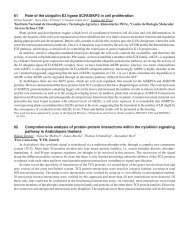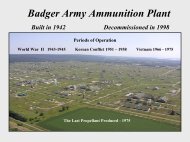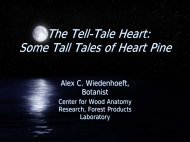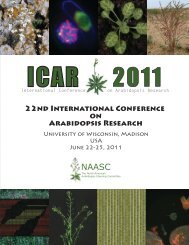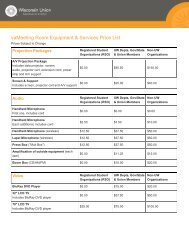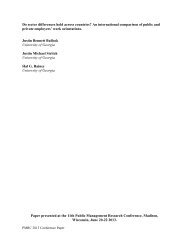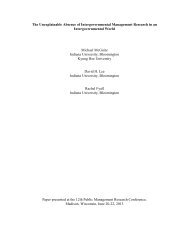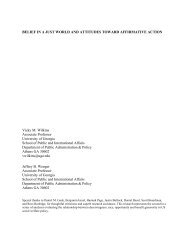PROGRAM & ABSTRACTS - Wisconsin Union - University of ...
PROGRAM & ABSTRACTS - Wisconsin Union - University of ...
PROGRAM & ABSTRACTS - Wisconsin Union - University of ...
Create successful ePaper yourself
Turn your PDF publications into a flip-book with our unique Google optimized e-Paper software.
Aging, Metabolism, Stress, Pathogenesis, and Small RNAs in C. elegans Topic Meeting 2012<br />
Mitochondrial Oxidative Stress in C. elegans Alters a Pathway with<br />
Strong Similarities to that <strong>of</strong> Bile Acid Biosynthesis and Secretion in<br />
Vertebrates<br />
Ju-Ling Liu1 , David Desjardins1 , Robyn Branicky1,2 , Luis B. Agellon1 , Siegfried Hekimi1 1 2 McGill <strong>University</strong>, Montreal, Canada, MRC Laboratory <strong>of</strong> Molecular Biology,<br />
Cambridge, UK<br />
Mammalian bile acids (BAs) are oxidized breakdown products <strong>of</strong> cholesterol whose<br />
amphiphilic properties serve in lipid and cholesterol uptake. BAs also act as hormonelike<br />
substances that regulate metabolism. The C. elegans clk-1 mutants sustain elevated<br />
mitochondrial oxidative stress and display a slow defecation phenotype that is sensitive to<br />
the level <strong>of</strong> dietary cholesterol. We found that: 1) The defecation phenotype <strong>of</strong> clk-1 mutants<br />
is suppressed by mutations in tat-2, identified in a previous unbiased screen for suppressors<br />
<strong>of</strong> clk-1. TAT-2 is homologous to ATP8B1, a flippase required for normal BAs secretion in<br />
mammals. 2) The phenotype is suppressed by cholestyramine, a resin that binds BAs. 3) The<br />
phenotype is suppressed by the knock-down <strong>of</strong> C. elegans homologues <strong>of</strong> BA-biosynthetic<br />
enzymes. 4) The phenotype is enhanced by treatment with BAs but not by other detergents.<br />
5) Lipid extracts from C. elegans contain an activity that mimics the effect <strong>of</strong> BAs on clk-1 and<br />
the activity is more abundant in clk-1 extracts. 6) clk-1 and clk-1; tat-2 double mutants show<br />
altered cholesterol content. 7) The clk-1 defecation phenotype is enhanced by high dietary<br />
cholesterol and this effect requires TAT-2. 8) Suppression <strong>of</strong> clk-1 by tat-2 is rescued by BAs,<br />
and this requires dietary cholesterol. 9) The clk-1 phenotypes, including the level <strong>of</strong> activity<br />
in lipid extracts, are suppressed by antioxidants and enhanced by depletion <strong>of</strong> mitochondrial<br />
superoxide dismutases. Our observations suggest that C. elegans synthesizes and secretes<br />
molecules with properties and functions that resemble that <strong>of</strong> BAs. These molecules act in<br />
cholesterol uptake and their level <strong>of</strong> synthesis is up-regulated by mitochondrial oxidative<br />
stress. Future investigations should reveal whether these molecules are in fact BAs, which<br />
would suggest the unexplored possibility that the elevated oxidative stress that characterizes<br />
the metabolic syndrome might participate in disease processes by affecting the regulation <strong>of</strong><br />
metabolism through BAs synthesis.<br />
Contact: ju-ling.liu@mail.mcgill.ca<br />
Lab: Hekimi<br />
22<br />
Session 3



